Some of the arguments in favour of the Free Tram Zone seem very simplistic.
Shaun Carney built a whole opinion piece around this in the Herald Sun on Thursday: basically, it doesn’t matter if it’s poorly thought out, sucks away resources, and doesn’t get people out of cars — if it’s cheap or free, it must be good — and hang the consequences.
Things aren’t that simple.
The Free Tram Zone is not without its advantages, of course. Here are some pros and cons to ponder.
Pros of the Free Tram Zone
Given the decision to scrap short term tickets under the Myki system, and the ridiculous situation of no facility to buy or top-up a Myki on-board a tram, it’s helpful for tourists and other occasional users in the CBD and Docklands.
In fact it can probably be sold to prospective tourists as a feature. It’s handy for instance to be able to catch a free tram to the Skybus terminal, rather than waiting for their less-frequent hotel shuttles.
It might help reduce congestion in the CBD, particularly from short distance taxi trips.
It may help relieve the crowding on the City Circle, which has been problematic for years, particularly on Flinders and Latrobe Streets.
Some streets seem to be coping fine with loads. From what I’ve seen, Collins and Elizabeth Streets seem pretty much okay most of the time (thanks to many routes serving them). William Street is managing, despite probably having the CBD’s least frequent service. I haven’t looked closely at the others. This may change over time of course.
It’s difficult to touch-on a Myki on packed trams, so it saves people the trouble.
If people don’t touch on and off, it may help cut tram loading delays at some stops.
It gets more people onto public transport, including some who wouldn’t otherwise use it.
The maps, signage and announcements (at least on trams where they’re automated) are pretty clear about where the Free Tram Zone starts and ends.
Cons of the Free Tram Zone
Crowding seems to be getting worse on some streets. This is particularly a problem on Bourke Street, probably more so than any other street. On Bourke Street there is route 86 (every 7-8 minutes weekdays off-peak) and route 96 (ditto), and on paper at least they’ve spaced them evenly for a tram every 3-4 minutes.
But in practice delays occur resulting in gaps of ten minutes or more, followed by several jam-packed trams in a row. This photo on Friday shows on route 96, there was going to be one tram (the one I shot footage from within, below) then a 15 minute gap, followed by 2 trams within 2 minutes. There was also a short delay on route 86 at that time, resulting in gaps of up to 7 minutes — enough for significant crowds to build up.
This could be countered by running short services just through the CBD. But the most recent change was that Bourke Street actually lost its short route 95 services last year in a route revamp. The simplicity is welcome, but the crowding isn’t.
(Since this post, route 86a short runs have been implemented along Bourke Street.)
Or it could be fixed by resolving delays along the routes, so that more trams got to the CBD on schedule. This is mostly due to lack of traffic light priority, but there seems to be little appetite to fix this, and even if there was, it’s a challenging exercise to eliminate all delays.
Delays compound as more people try to pack in, of course, making the problem worse, and resulting in delays right along each route.
As a paid customer, I’m not very impressed with the change, or at least the resultant crowding, and I don’t seem to be the only one.
Here’s video showing what is becoming more common. The video below is in two parts: Inside the tram was shot on Friday at 2:01pm at the Bourke Street Mall stop, westbound on route 96. Outside the tram (apologies for the horrible mobile phone audio in this second clip) was shot on Thursday at 1:33pm at the same location. Note the doors are open for a full minute before the tram can move off again.
Is there space inside the tram in front of the lady with the stripy shirt? I don’t think there was — I think there were people of diminished height not visible in the video. People were left behind at the stop, and TramTracker said the next tram (86 or 96) was 7 minutes away, by which point the crowd would have built up again.
If you have a pram or a wheelchair, you’re probably wanting a low-floor tram. Finding one with space aboard, especially on Bourke Street, just got a lot harder. (I’m amazed the two in the video above squeezed on; the lady on the left had help from one passenger who appeared to give up his space. The bloke on the right appeared to get a bit narky with the crowd.)
Similarly, if you want a specific route, things are now more difficult. You might want to consider catching whichever tram comes first out to the edge of the Free Tram Zone where the crowding is less worse, and waiting for your route there… if you wait for it at one of the busier stops, there’s a real risk you won’t be able to fit on board.
The lunchtime peak seems to be getting longer. Of course CBD trams have always been packed at lunchtime, but my impression is the period of the worst crowding is lasting longer into the afternoon. This photo was taken moments before the video from inside the tram, above, at 2pm:
The cost is a problem. Fare changes this year are estimated to be costing about $100 million per year, though I’d suspect most of that is the zone 2 change. But that may go up if they have to put more resources into easing crowding. Revenue reductions mean less funding available for service upgrades.
Those who primarily benefit are tourists (who can probably afford tram fares), CBD residents (who can probably afford tram fares), international students (as long as they primarily live, study and travel within the CBD), and motorists (who don’t need encouragement to drive to the CBD, and can probably afford tram fares).
In fact almost nobody who catches public transport into the CBD and out again benefits (with the exception of Earlybird passengers). You have CBD travel already included in your fares, including if you’re using V/Line. (It’s unlikely many Earlybird passengers benefit on the way to work, as apart from Docklands, no spot in the Free Tram Zone is more than two stops from a railway station.)
The Free Tram Zone falls short of some major tourist destinations — it ends one stop before the Casino (on both route 55 and routes 12/96/109), the Museum (86/96) and the National Gallery of Victoria (Swanston Street routes). Of course the zone has to end somewhere. But if you’re going to have it (and I don’t think you should), then if it’s going to stretch to the Victoria Market and cover all of Docklands, shouldn’t it also stretch to these major attractions?
Despite good signage, at stops and shelters, on platforms, on trams, there seems to be some confusion about where the zone applies. Authorised Officers have been spotted just outside the zone boundaries. Hardly surprising though, is it? (That 3AW story also quoted a lady claiming there is no information online. Not so — it’s very prominent on the Yarra Trams, PTV, and City of Melbourne web sites.)
It will get more people onto public transport, but may do little to encourage mode shift from cars. Many people may be switching from walking instead, and it may encourage motorists to drive into the CBD and Docklands, knowing they can catch free trams (though fortunately the CBD parking levy zone is larger than the Free Tram Zone).
It may not be good health policy. I don’t suppose there’s any firm information yet, but one friend who works in this area suggested to me that it is likely to cut the amount of incidental exercise some people get. As an example, I saw one lady on Friday, in fine weather, board a tram at Queen Street for a ride of less than a block, to William Street. She didn’t appear to be a lost tourist.
If don’t they put more trams onto the CBD routes, crowding will probably get worse. If they do, they’re effectively diverting resources for no revenue gain, while people in the suburbs who are crying out for better services (many with currently only one bus per hour) and who are willing to pay a fare, miss out.
I don’t know if there are commandments for economics, but if there are, surely there must be one that says you don’t give away a product people are willing to pay for. It seems madness that there was heavy demand for CBD trams when fares applied, and they just made them free. It’s a curious thing to decide to increase subsidies for.
Note that (going into the 2014 election) the Coalition had a plan to expand the E-class tram order by another 50. This would eventually have added to tram capacity. No word from Labor on this.
If you do touch-on within the Free Tram Zone, you’ll get charged. If you touch-off within the FTZ, and want to bother, you can probably get a reimbursement. Should they have properly programmed the FTZ into Myki? Perhaps — there used to be a “Zone 0” for the City Saver Zone… but it’s unclear if it could have handled a zone being free, and it would mess with Tram Zone 1 Default Fares… and Myki GPS is hopeless, so who knows if it would have worked.
(Remember, if you were using public transport to get into and out of the CBD anyway, and you were going to pay a daily fare anyway, it doesn’t matter if you get charged for a CBD tram trip.)
The Myki message has changed over the years from the simple consistent “Top-up, Touch-on, Touch-off”, to having a raft of exceptions. On trams it’s now touch-on… unless you’re travelling entirely in the Free Tram Zone. Touch-off… only for trips entirely in Zone 2. Confused yet?
Meanwhile, more and more people are returning to work throughout January. It’ll be interesting to see just how crowded it gets.
So, there are pros and cons
So there is good and bad from the Free Tram Zone. It’s not all bad, and it’s not all good — it’s more complex than that.
The problem with free things is, someone has to pay for them.
I still think the bad outweighs the good, but I suppose we’re stuck with it for now.
And if you’re trying to get east-west across the city and want to avoid the crowds, you might want to consider the Lonsdale Street buses. Not free, but not swarming with people either most of the time.
- Shaun Carney’s piece seems to have been directly inspired by this article in The Age: Free Melbourne tram ride may lead to overcrowding warns transport group
- From last August: the big picture — Giving with one hand, taking with the other: 2014-15 Myki fare reform
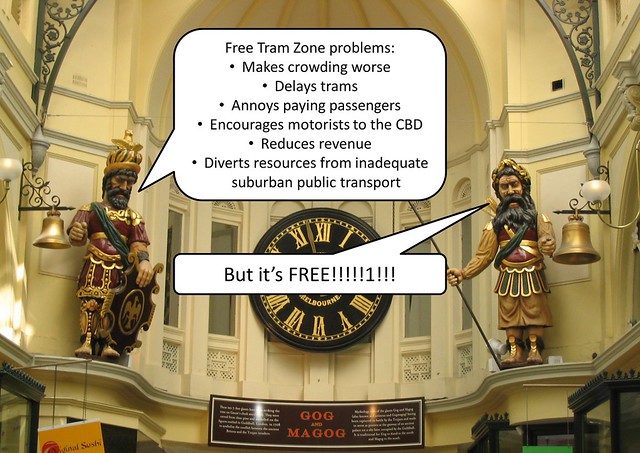
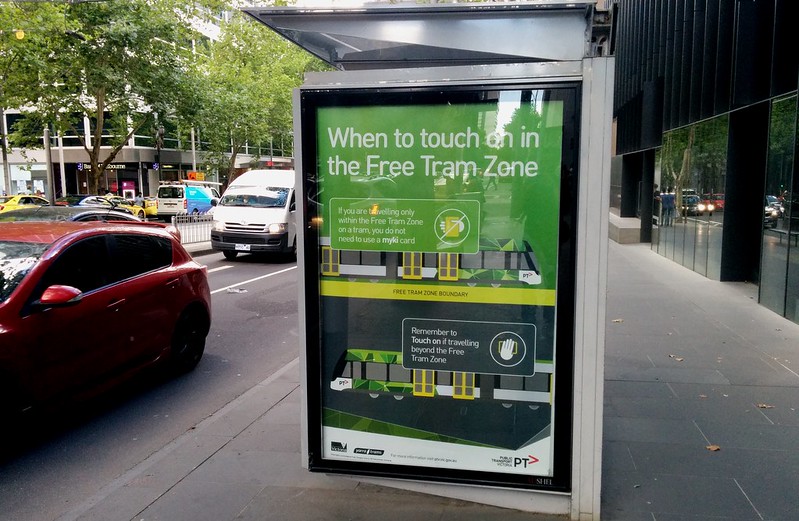
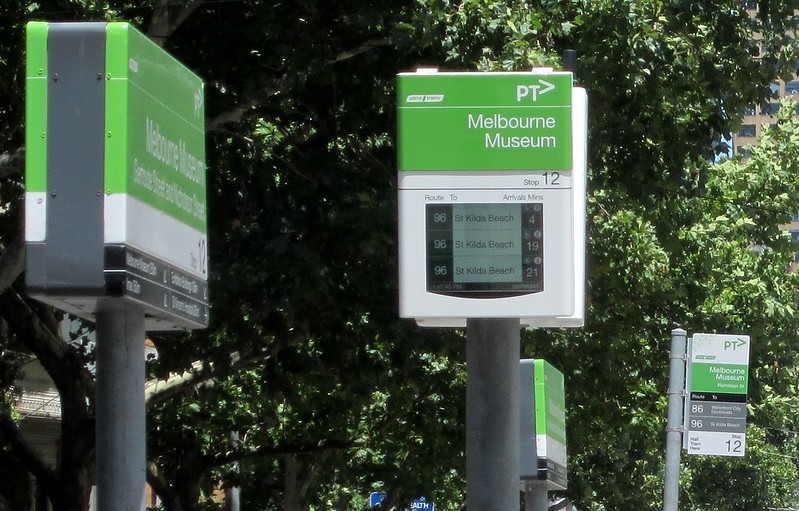
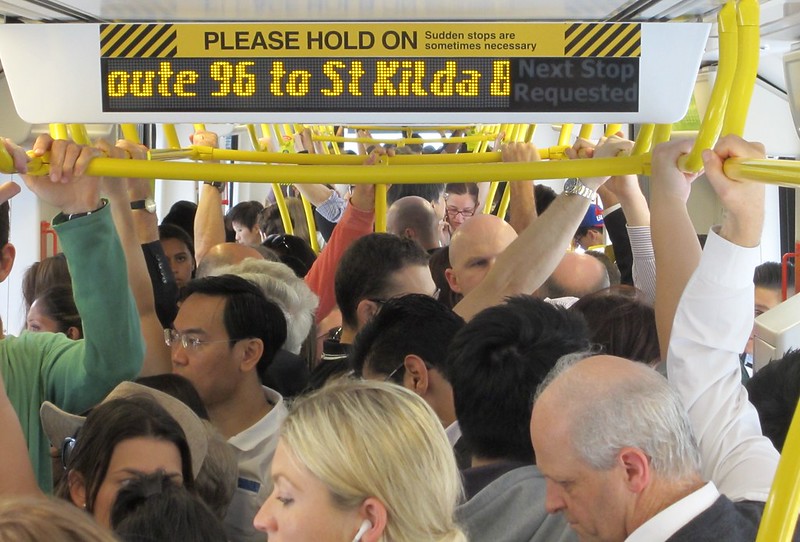
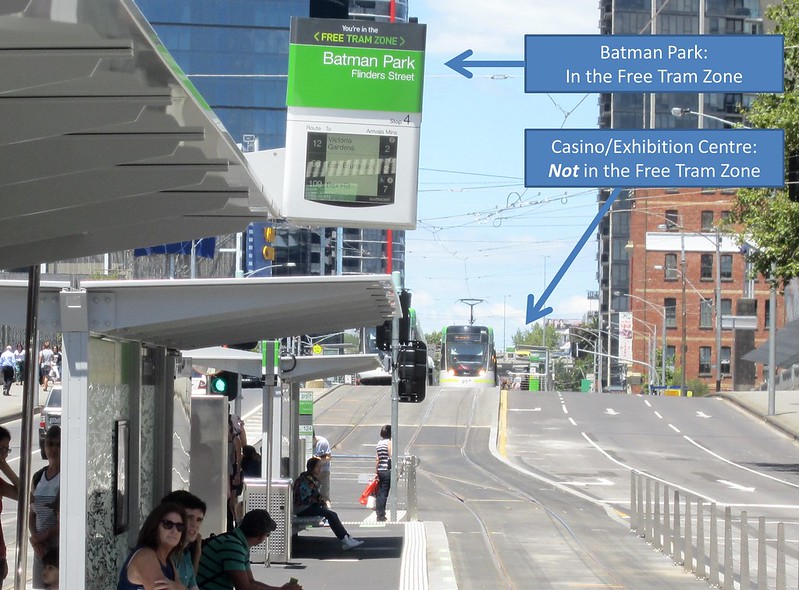
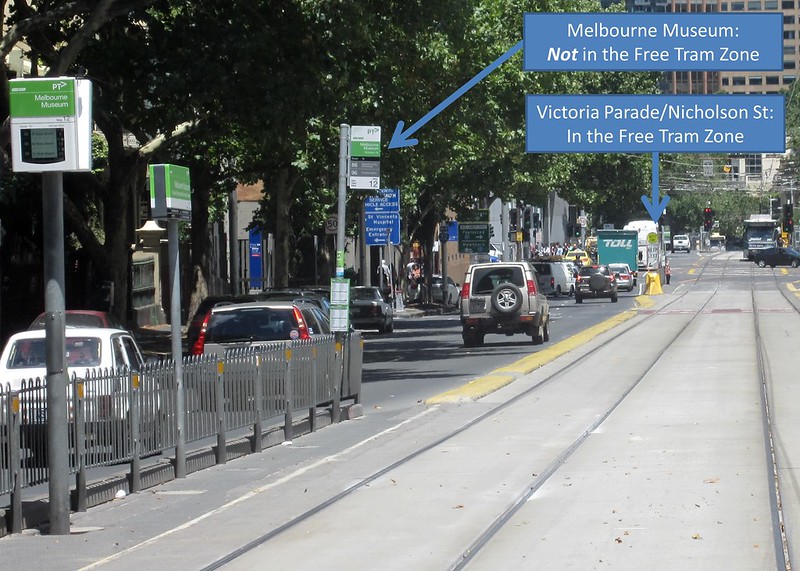
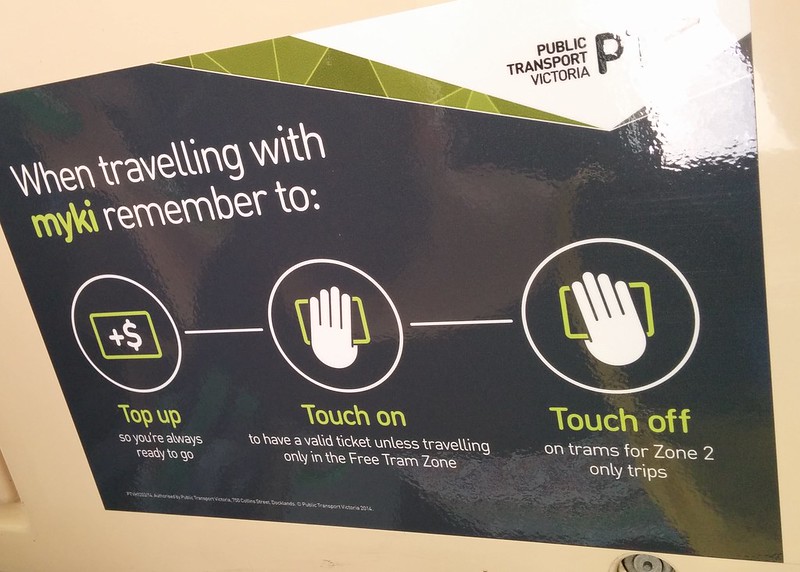
21 replies on “The pros and cons of the new #FreeTramZone”
Yes, exactly my points. generally. It only encourages car use into the city.
Who would benefit from any of this??
The following public transport users who arrive in the city by public transport, do not get free travel on the trams,…
…..Country Link/NSWTrains XPT
…..GSR ‘The Overland’?
People who come into the city the day before on a V/Line service, and out the day after, staying two night in the city. The odds are, they would not even have a MyKi.
Nice work. I heard Yarra Trams fought tooth and nail against the free zone, to no avail.
I used to support universal free PT unequivocally. A friend related an experience from living in Havana during the Special Period in the 90s (after they lost their Soviet bloc trading partners), the oil shortage meant they were encouraging people onto buses, so they made them free. They found too many people were crowding on for very short trips that they could just as easily have walked. So fares (probably small) were reinstated.
I think in Melbourne, most people would be happy to pay for PT if the service was improved to a reasonable level (frequency, etc). As an exception, I think it should be free, statewide, for people on concession cards, at least while government benefits/pensions etc are so appallingly low. The problem is, the government thinks the way to increase revenue is to hike fares, not to provide better services and attract more passengers. In fact, packing more people onto less services is good business sense. I know they aren’t meant to be that, but sometimes you do wonder!
Thankyou for the enjoyable post, Its good to hear that you are trying to see the bright side of the free fare zone however the pros as you have stated are heavily outweighed by the cons and we wouldn’t the state government to spin this in their favour.
Most of those pros such as not having having to swipe on will only mean that the operator will have no usage data which will make it difficult to plan services.
Not having to swipe on and no short term tickets is a fault of the transport planner and will not solve the problem of visitors needing to go the inner city or other trips.
A lot of short trips will transfer trips from walking to trams not from driving to trams, so there will be little effect on congestion (short distance car trips are a very small percentage of trips in the CBD). Reduced short taxi fares will probably increase empty taxis cruising the CBD looking for fares increasing congestion not reducing it.
IMO the benefits are close to the zero while the costs are significant in terms of millions of dollars lost in revenue, extra confusion, overcrowding at exactly the same time that the trams don’t have capacity as well as sending totally uneconomic price signals to commuters. I would say the cost to benefit ratio is about 20 to 1.
Another potentially big group of beneficiaries who don’t seem to get mentioned are people who cycle into the CBD. For so many transport planners, people who use two forms of public transport but not as part of the same journey are too complicated to plan for. I sometimes wobble in to town (e.g. tomorrow), park up, shower and go to a client site. I then get around the city to other client sites by tram before wobbling back home on the bike (or losing enthusiasm at Kooyong and training home). If I cycled both ways, instead of a Z1&2 fare I just had a Z1 fare if I used a tram. Or walked to save money. Now I have no fare at all if I use the tram in the FTZ. (And the Z1/2 thing means that I only save a Z1 fare. Way too complicated to even think about!). How many people cycle into town? How many would go out, say, at lunchtime? Definitely beneficiaries (who don’t need any more exercise!).
Part of the problem, is that a very short tram trip in Melbourne is ridiculously expensive.
I looked at a double-sided pamphlet about the free tram zone, which was available from a stand on the tram. It was full of words and graphics, but didn’t include a MAP of the ZONE!! What’s the point of that? The other stuff was nowhere near as useful as an actual map to tell you where the zone is. All it said about the location of the zone was that it is the CBD.
@Robert, good point. Not that one would necessarily assume this group needs free rides, but it may encourage more cyclists.
The flip side is, as someone pointed out to me: what of the bike hire scheme? Will free CBD trams limit its usefulness, at least for trips within the zone? At least some pods are outside the zone, such as Melbourne Uni.
@Philip, that’s odd – a flyer I was given included the zone map on one side. There must be some different flyers around the place.
Good write-up, Daniel. Bourke Street trams are definitely becoming pretty clogged (although they were already fairly busy before the change).
Your photos of the Crown/Batman Park and Nicholson St/Museum tram stops are a pretty good illustration of one other problem in Melbourne’s tram network – stops being ridiculously close together! This must add significant overhead to journeys with trams being required to stop far more often than they ought. Another prime example is in the Docklands section of Collins Street, where four tram stops are within about 500m of each other – a distance that could just as effectively be served by having one stop at either end.
One of the benefits of the new Gold Coast light rail is how quick journeys are – partly because the tracks are mostly separate from the road, but also because they don’t have to stop every 75 metres to pick up passengers. Some of this thinking applied to Melbourne’s tram network would certainly help reduce travel times and make tram trips more attractive.
@Aaron This is a Melbourne wide problem that includes train stations and bus stops. The only issue is that people will complain that there isn’t a stop less than 20 metres away from their destination. Similar to the Zone 1 fare problem this policy of to many stops is driven by politics not logical planning.
Is this a symptom of another ‘overloading problem’ with the MyKi server.
It was said that, by removing zone 3 from the system was to ease the pressure on the MyKi central server. The benefit now is, especially now we include V/Line, the server has a massive drop in the fares list to which it must calculate from.
At least that is what was being said at the time.
Is this ‘Free zone’ in the city, in effect meant to remove yet another loading on that same system?
Or, is it some means to mitigate the impact on tourists who need to pay $6 just to buy a MyKi card then fare on top. By removing the need to use a ticket should remove that embarresment by the government. How many tourists would depend on getting around in only the CDB, especially when they are only staying for one or two nights.
And oh, Skybus does not have MyKi. There is another corridor of ‘non myki’ passengers heading into the city.
@Aaron and Llib, also agree that stop distancing needs to be improved, but the PTUA isn’t fond of stop removal, especially in the CBD.
However, one of my pet hates is stop placement, especially in terms of buses. Stops should be placed in order to maximise coverage (by minimising walking distance); therefore, adjacent to major pedestrian thoroughfares and close to interchanges. There seems to be a trend of putting stops in inconvenient locations. In terms of tram stops, this can be seen particularly at the Spencer Street stop on Collins St which is placed half a block down the road from Southern Cross Station. A short distance, but may mean the difference between making or missing your train. In terms of bus stops, pretty much anywhere in newer growth areas where bus stops seem to be placed purposely as far from main roads, train stations (cough Laverton and Deer Park) and other routes as possible.
@James
I vaguely remember the debate back then about the stop removals in the CBD however my arguments were more outside the CBD were the density is lower and the stops need to be rationalised. One example is the Alamein train line were Riversdale and Willison stations should be closed and a new station be built closer to Riversdale Rd to interchange with the trams. Or Glenbervie on the Craigieburn Line which is close to Strathmore and has few opportunities to interchange with other means of transport.
In regards to Spencer St I agree with you 100% as there is no stop on the corner of Spencer St’s and Collins yet this area is saturated with too many stops except where one is needed the most which is on that specific corner.
Of course you need tram light priority (and some bus priority) to make the stop rationalisation effective as the trams (and buses) will stop at red lights anyway.
@Llib, agreed on all those points. The Alamein Line should ideally have only 3 stations: Riversdale Road, Toorak Rd and Ashburton, all underneath/above their respective roads with seamless connection to trams/buses. In the future, it could be extended to at least East Malvern to connect with the Glen Waverley line. I’d like to see quite a few other stations closed too. Middle Footscray, Aircraft, Chatham, Rushall etc
Ticket inspectors are already waiting until one stop past the end of the free tram zone to catch people who haven’t touched on their Myki.
Good summary of the pros and cons, Daniel. And refreshing, as I find many supporters of public transport are leftie types who often give the impression that they think that the government (rather than the user) should pay for everything, and that free services are not abused. (In this case I suspect, as Carney hinted, that the Greens oppose the free travel because they are opposing Labor, not because they don’t like the idea.)
Regarding close stops, I want to put a counter argument. There is a trade-off between number of stops and speed of services. Trams typically have more of the former and less of the latter, while suburban rail is the other way around. Light Rail is somewhere in between.
Trams in Melbourne have always been popular. Is this despite close stops, or because of them? No matter how much we might argue that people are capable of walking a bit further, or that it would do them good to do so, I suspect that a large part of the attraction of trams is their convenience in having stops near where people are. Why, for example, has the Sydney Road tram traditionally been very popular and the adjacent Upfield railway line less so? Part of it would be more frequent services, but part would be convenience of being where people are. The train is faster, but involves more walking to get there.
And although I hate to say it (because I think services should be faster to be more competitive), recent growth in the suburban rail system has occurred alongside services getting slower because of less express running (because of greater frequency).
The suggestion for only three stations on the Alamein line (plus Alamein??) seems to assume that everyone will travel to the station by public transport, ignoring all those who walk to their nearest station.
I’m not saying that selected stops and stations shouldn’t be closed. I’m simply pointing out that there are other considerations that haven’t been mentioned. And that I see little evidence that not closing stops/stations is nothing more than politics because some people might unreasonably complain.
I agree with John. Jarrett Walker talks a lot about the trade off between stop spacing and speed in his book Human Transit and his blog of the same name. I recommend the book to anyone who is interested in PT planning.
He argues that most people walk to a PT stop and they are generally willing to walk around 400m to get there. This figure can go up to around 1km for a more frequent service but will go down for other reasons for example, if there are hills or if the person in question is less physically able. To reduce the Alamein line to three stops would make them all over 1km apart.
Within these margins stop spacing depends upon the nature of the route. If you are offering an alternative to walking such as with trams in the CBD stops should be close together so that people do not have to walk far once they get off the tram to get to their destination. On the other hand if you are trying to provide an alternative to driving as is often the case with Melbourne’s trains the stops should be further apart to increase speed.
@ John
The stops referred to in my previous post and by James are mainly suburban stops in which the rationalised stops only add slightly to walking distances. As you can see with Willison on the Alamein line, the permeability around the station is not very good and a station closer to Riversdale Rd would be easier to walk to.
An increase in connectivity between trams and trains is critical to not only attracting passengers but also attracting them where the services have plenty of spare capacity.
The extension of the tram line 109 to Box Hill station allowed many outer suburban travellers to transfer at Box Hill station and continue there journey to Balwyn and Kew. This type of transfer allowed for journeys were both the trams and trains are at below maximum capacity because they are in the outer suburbs which is were they are still quite empty.
Better multi modal transfers and rationalised stop spacing are also important to allow competition with private vehicles in the suburbs because it improves their convenience and their speed against cars.
The free tram in the city makes a lot of sense. Previously, weekly or monthly pass holders did not have to touch on or off on a tram. This was confusing as folks sitting on the tram would see this person board and think “they are cheating the system”. (The non touch on or off requirement was not broadcast very well).
Now, all the government did was realise a couple of things with Myki – if every single person touched on and off every time they boarded a tram (in the city), then it would never leave. It would take a lot longer than the minute complained about in the article. In the city, with a build up of so many commuters, shoppers, workers and residents, making the trams free within the city zone is a brilliant idea…and so far, I have not seen any Ferrari drivers parking and using it (a fear of Joan Kirner). The free trams just mean that you do not have to touch on or off and saves a lot of time.
Thinking through it rather than just from a simple money point of view, it makes a lot of sense.
Daniel,
You missed one section of the public who will benefit from the free cbd trams. People who commute to work by bike.
I’m a suit. Like many people I know I ride to work. Once at work though if I’m going to a meeting (almost invariably with colleagues) I never ride. It’s not professional enough. I therefore have a choice: PT or taxi. Since the introduction of free cbd tram travel the number of trips i have taken by tram as opposed to taxi has easily doubled.